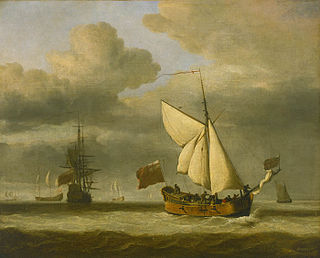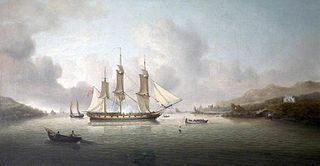USS Growler was a 112-ton sloop-of-war, armed with ten 18-pounders and one 6-pounder, during the War of 1812. The United States Navy purchased Growler on Lake Champlain in 1812. The British captured her in 1813 and renamed her HMS Chub or Chubb. The Americans recaptured her at the Battle of Lake Champlain. She was sold in 1815.
Three Royal Navy ships have borne the name HMS Lutin or Lutine, Lutine being French for "the tease" or "tormentress" or more literally "imp", and Lutine the feminine:

HMS Armada was a Royal Navy 74-gun third-rate ship of the line, launched in 1810. She was the first ship to carry the name. After a relatively undistinguished career, Armada was sold out of the Navy in 1863 and broken up at Marshall's ship breaking yard in Plymouth.

HMY Royal Escape was a royal yacht used by King Charles II. She was a former collier in coastal trade named Surprise.
Eight ships of the Royal Navy have borne the name HMS Espiegle
HMS Valeur was a 28-gun sixth-rate frigate of the Royal Navy, initially launched in 1754 as the Valeur for the French Navy, and classified by them as a corvette. The British captured her in 1759. In Royal Navy service she captured several merchant vessels and privateers before she was sold in 1764.
HMS Cydnus was one of eight Royal Navy 38-gun Cydnus-class fifth-rates. This frigate was built in 1813 at Blackwall Yard, London, and broken up in 1816.
HMS Electra was a 16-gun brig-sloop. She was built by the Enterprise Ethéart, Saint-Malo, as the French Curieux-class brig Espiègle and launched in 1804. She was armed in 1807 at Saint Servan. The British frigate Sybille captured her on 16 August 1808. There was already an Espiegle in the Royal Navy so the Navy took the vessel they had just captured into service as HMS Electra, her predecessor Electra having been wrecked in March. Electra captured one American privateer before she was sold in 1816.
Three ships of the Royal Navy have borne the name HMS Chub, or alternatively HMS Chubb, a name given to several types of fish, many in the family Cyprinidae:
Only one vessel of the Royal Navy has borne the name HMS Colibri, after the Colibri, a genus of hummingbird. There was to be a second vessel of the same name but she was never completed. The two vessels were:
Three, and possibly five, vessels of the Royal Navy have borne the name HMS Sultana, for a female sultan or wife of a sultan:
HMS Adonis was the name vessel of her class of schooners of the Royal Navy during the Napoleonic War. She was built at Bermuda using Bermudan cedar and completed in 1806. She had a relatively uneventful career, primarily on the Newfoundland station, before the Admiralty sold her in 1814. She then became the mercantile Adonis and sailed to Africa and the Indian Ocean until she was wrecked in June 1835 on the Maldive Islands.
HMS Jahde was a Dutch schuyt of six guns and 47 tons burthen that the Royal Navy captured in 1809 and took into service. She was the only vessel of her name to serve in the Royal Navy. No vessel by that name appears in Colledge & Barlow (2006). She served until she was sold in 1815.
HMS Patriot was a Dutch schuyt that the Royal Navy captured in 1808 and took into service. She captured several enemy vessels before she was converted to a water vessel in 1813. The Admiralty sold her in 1815.

HMS Delight was a British Royal Navy 16-gun brig-sloop of the Seagull class launched in June 1806, six months late. She grounded off Reggio Calabria in January 1808 and was burnt to prevent her being salvaged.
Sphinx , was a French Sylphe-class brig launched at Genoa in 1813. She was handed over to naval suppliers at Genoa on 17 April 1814 when nearly completed as part-payment for debts. The next day the British occupied Genoa. Sphinx appears to have become the Royal Navy brig Regent, and then a Customs and Excise cruizer. Regent was sold in 1824, and then appeared as the Colombian government vessel Victoria, which is no longer traceable in online resources after 1828.
The French schooner Découverte was a French Navy vessel launched in 1800. The British captured her at Santo Domingo in 1803 and took her into service as HMS Decouverte. She was decommissioned in January 1806 and sold in 1808.
Alarm was a lugger that the British Royal Navy acquired from the Commissioners of Customs in 1810. She made one small capture before the Navy returned her to Customs in 1812.

HMS Enchantress was the mercantile vessel of the same name, launched in 1802 at Ringmore. The British Royal Navy purchased her in 1804. She then spent her career sitting at Bristol serving as a storeship. She was transferred to the Customs service in 1817 and may have served with it until c.1850.
Badger was launched in 1803. She served as an Excise Cutter, a hired armed cutter serving the British Royal Navy, and then as a merchant vessel. She was last listed in 1822.



